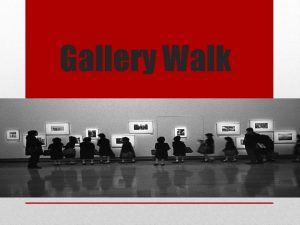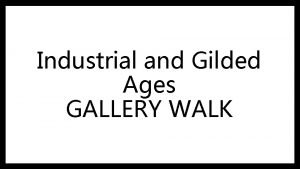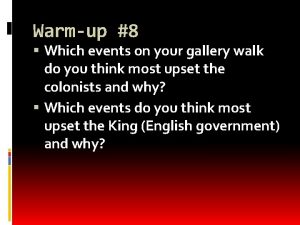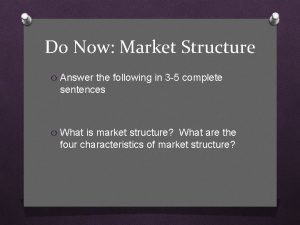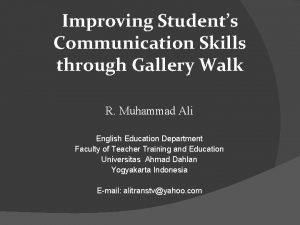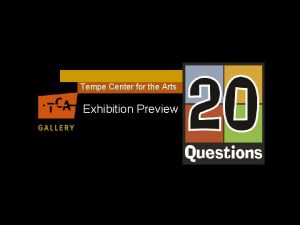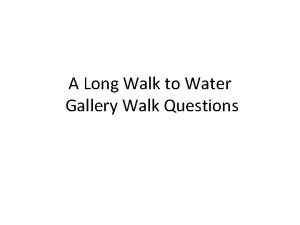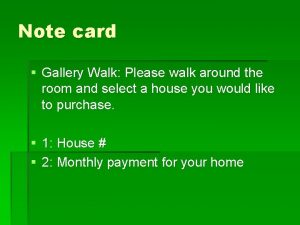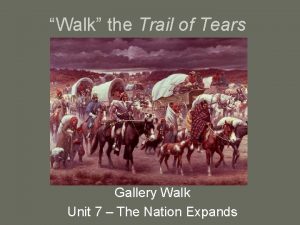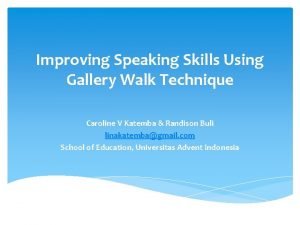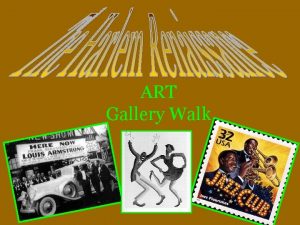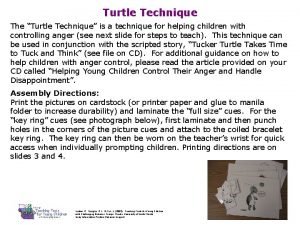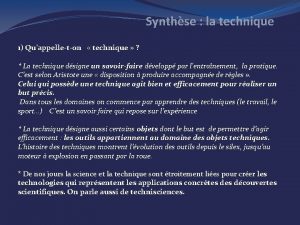Gallery Walk Gallery Walk is a discussion technique













- Slides: 13

Gallery Walk

• Gallery Walk is a discussion technique that gets students out of their chairs and into a mode of active engagement. The advantage of the method is its flexibility and the variety of benefits for students and instructor alike. • For students it's a chance to share thoughts in a more intimate, supportive setting rather than a larger, anonymous class. • For instructors, it's a chance to gauge the depth of student understanding of particular concepts and to challenge misconceptions.

• A Gallery Walk can be conducted with computers (a "Computer Run"), with pieces of paper on tables, or with posted chart paper. It can be scheduled for fifteen minutes (a "Gallery Run") or for several class periods.

• During a Gallery Walk, students explore multiple texts or images that are placed around the room. Teachers often use this strategy as a way to have students share their work with peers, examine multiple historical documents, or respond to a collection of quotations. Because this strategy requires students to physically move around the room, it can be especially engaging to kinesthetic learners.

• Select the texts (e. g. quotations, images, documents, and/or student work) you will be using for the gallery walk. You could also have students, individually or in small groups, select the text for the gallery walk. Step one: Select texts

• Texts should be displayed “gallery-style” - in a way that allows students to disperse themselves around the room, with several students clustering around a particular text. Texts can be hung on walls or placed on tables. The most important factor is that the texts are spread far enough apart to reduce significant crowding. Step two: Organize texts around the classroom


• Viewing instructions will depend on your goals for the activity. • If the purpose of the gallery walk is to introduce students to new material, you might want them to take informal notes as they walk around the room. • If the purpose of the gallery walk is for students to take away particular information, you can create a graphic organizer for students to complete as they view the “exhibit, ” or compile a list of questions for them to answer based on the texts on display. Step three: Instruct students on how to walk through the gallery


• promotes higher order thinking, oral/written presentation skills, and team building • Gallery Walk is flexible and has many benefits. Gallery Walk can be organized for a simple fifteen minute ice breaker or for a week long project involving graded oral and written reports. In addition to addressing a variety of cognitive skills involving analysis, evaluation, and synthesis. Why use Gallery Walk?


• - English can take parts of a poem, short story, or text and encourage students to discuss symbolism, identify parts of speech, and discuss meanings. - Social Studies can use the activity to address various political cartoons or examine images from historical periods and gather students’ thoughts. - Government students can use this to decide whether something is constitutional or unconstitutional and have students explain why. - Mathematics teachers can provide images of Geometric figures and discuss the various concepts that are covered. Students could solve a problem and then write a problem for the next group to solve. - Science teachers could use the activity related to outcomes of experiments - PE and Health teachers could use the activity as a way for students to share a game they create and other students could comment and add to them - Arts and Humanities teachers could use this strategy to examine art or even share student created projects Implementation Ideas

Thank You
 Gallery walk technique
Gallery walk technique Gilded age gallery walk
Gilded age gallery walk Gallery walk rubric
Gallery walk rubric Causes of the american revolution gallery walk
Causes of the american revolution gallery walk 5 themes of geography poster
5 themes of geography poster Market structures gallery walk answers
Market structures gallery walk answers Gallery walk
Gallery walk Fractional distillation discussion
Fractional distillation discussion Chapter 40 walk two moons
Chapter 40 walk two moons Denise yaghmourian
Denise yaghmourian Artame gallery
Artame gallery The gallery collection corbis
The gallery collection corbis Gta v gallery
Gta v gallery Theme gallery.in
Theme gallery.in
